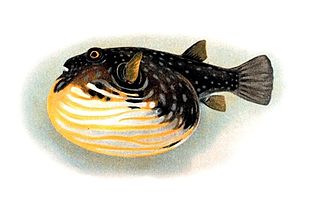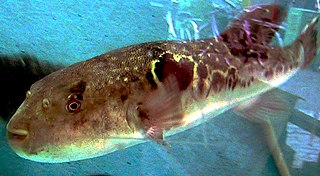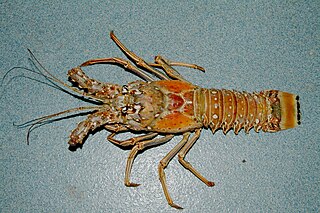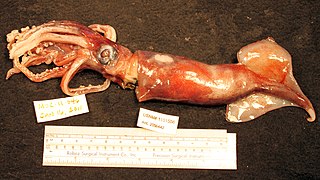
Tetraodontidae is a family of primarily marine and estuarine fish of the order Tetraodontiformes. The family includes many familiar species variously called pufferfish, puffers, balloonfish, blowfish, blowers, blowies, bubblefish, globefish, swellfish, toadfish, toadies, toadle, honey toads, sugar toads, and sea squab. They are morphologically similar to the closely related porcupinefish, which have large external spines.

Takifugu, also known by the Japanese name fugu, is a genus of pufferfish with 25 species, most of which are native to salt and brackish waters of the northwest Pacific, but a few species are found in freshwater in Asia or more widely in the Indo-Pacific region. Their diet consists mostly of algae, molluscs, invertebrates and sometimes crustaceans.

The striped burrfish or simply burrfish is a member of the porcupinefish family Diodontidae.

The Mbu pufferfish, also known as Mbuna pufferfish, giant pufferfish, or giant freshwater pufferfish, is a carnivorous freshwater pufferfish originating from the middle and lower sections of the Congo River in Africa, as well as the east coast of Lake Tanganyika near the Malagarasi River mouth.

The narrow-lined pufferfish or striped puffer is a demersal marine fish belonging to the family Tetraodontidae.

Dichotomyctere ocellatus, commonly the figure 8 puffer or eyespot puffer, is a pufferfish found in freshwater in Southeast Asia. It is known from the lower reaches of the Mekong (Cambodia), the Peninsular Malaysia as well as Borneo.

The map puffer, also known as the map pufferfish, scribbled pufferfish, or Kesho-fugu, is a demersal marine fish belonging to the family Tetraodontidae. The map puffer is typically found in tropical and subtropical waters from the Indian Ocean to the western Pacific Ocean. This fish contains tetrodotoxin, a potent and deadly chemical compound used to ward off predators. Despite being highly poisonous, the map puffer can be found both in the aquarium trade and certain food markets.

Zombia antillarum, commonly known as the zombie palm, is a species of palm tree and the only member of the genus Zombia. It is endemic to the island of Hispaniola in the Greater Antilles. Usually found in dry, hilly areas of northern and southern Haiti and the northwest of the Dominican Republic, Z. antillarum is a relatively short fan palm with clustered stems and a very distinctive appearance caused by its persistent spiny leaf sheaths. Threatened by habitat destruction in Haiti, Z. antillarum is a popular ornamental species due to its distinctive appearance, low maintenance requirements and salt tolerance.

Panulirus argus, the Caribbean spiny lobster, is a species of spiny lobster that lives on reefs and in mangrove swamps in the western Atlantic Ocean.

Colomesus psittacus, the Banded puffer, parrot puffer or South American estuarine puffer, is a species of pufferfish found all along the Western Atlantic coastline of South America from the Gulf of Paria down to the mouth of the Amazon River in Brazil.

The northern puffer, Sphoeroides spheroides, is a species in the family Tetraodontidae, or pufferfishes, found along the Atlantic coast of North America. Unlike many other pufferfish species, the flesh of the northern puffer is not poisonous, although its viscera can contain poison, and high concentrations of toxins have been observed in the skin of Floridian populations. They are commonly called sugar toads in the Chesapeake Bay region, where they are eaten as a delicacy. There was widespread consumption of northern puffers during the rationing that accompanied the Second World War, establishing a commercial fishery that reached its zenith in the 1960s. In much of the Northeast, the fish is known simply as "blowfish" or "chicken of the sea". They may also be sold as "sea squab".

Plectropomus laevis, known commonly as the black-saddled coral grouper, cluespotted coral trout, blacksaddled coral trout, blue-spot trout, Chinese footballer, footballer cod, footballer coral trout, oceanic coral trout or tiger trout, is a species of marine ray-finned fish, a grouper from the subfamily Epinephelinae which is part of the family Serranidae, which also includes the anthias and sea basses. It is found in the Indo-Pacific region.

Canthigaster solandri, commonly known as the spotted sharpnose puffer, is a ray-finned species of fish in the pufferfish family. It grows to a length of 11.5 centimeters in total length. It lives in the tropical Indo-Pacific: from East Africa to the Line Islands and the Tuamotus, north to the Ryukyu Islands, south to New Caledonia and Tonga, to the Hawaiian Islands. This species, like other members of the family Tetraodontidae, demonstrates the ability to rapidly fill itself up like a water balloon, to protect itself from predators. The skin of this species is known to be poisonous.

Chilomycterus antennatus, the bridled burrfish, is a species of fish belonging to the family Diodontidae. It is native to the tropical waters of the Western Atlantic from southeastern Florida and the Bahamas to northern South America. They are also found in the Eastern Atlantic off the cost of Mauritania.
Hydrophis donaldi, or the rough-scaled sea snake is a unique species of sea snake from Australia's Gulf of Carpentaria first described in 2012. It is a yellow to brown, striped snake that reaches up to a meter in length. It gives live birth and is venomous enough to be dangerous to humans. The primary distinguishing trait of the rough-scaled sea snake is the presence of a single spine on every scale covering the snake's body. The snake's tough, spiny scales may protect it from being buffeted against the rocks of its stony estuary habitats by the action of the waves and currents. Other less spectacular traits distinguishing it from other members of the genus Hydrophis include the lack of a groove running through the scales underlying its abdomen, a larger and rounder skull, differing numbers of scales around the circumference of different bodily regions, and a larger number of stripes than many sea snakes have.

Chilomycterus is a genus of diodontid tetraodontiform fishes commonly called "burrfish."

Cyclichthys orbicularis, known commonly as the birdbeak burrfish among other vernacular names, is a species of marine fish in the family Diodontidae.

The Pacific spiny dogfish is a common species of the Squalidae (dogfish) family of sharks and are among the most abundant species of sharks in the world. This species is closely related to Squalus acanthias and for many years they were treated as a single species. Recent research, using meristic, morphological and molecular data led to the resurrection of the Pacific spiny dogfish as a separate species. The American Fisheries Society recommends the common name "Pacific spiny dogfish" for Squalus suckleyi over alternatives such as "spotted spiny dogfish" and "North Pacific spiny dogfish" and "spiny dogfish" for Squalus acanthias.

Ornithoteuthis antillarum, the Atlantic bird squid, is a species of flying squid from the family Ommastrephidae which is found in the warmer waters of the Atlantic Ocean. This species is an important component of the diet of many species of fish and of cetaceans. It is taken as a bycatch in fisheries but has the potential to be commercially important if appropriate fishing methods can be developed.


















